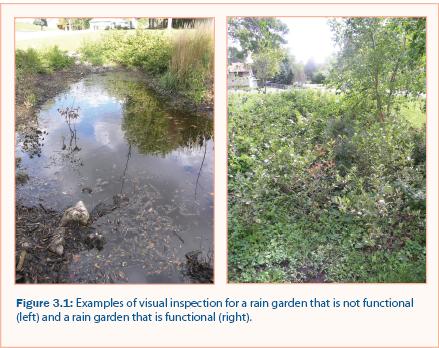
Visual Inspection
A.J. Erickson, P.T. Weiss, J.S. Gulliver, R.M. Hozalski, B.C. Asleson
The first level of assessment is visual inspection. Visual inspection involves inspecting a stormwater treatment practice for evidence of malfunction and can be accomplished with a brief site visit. Visual inspection can be used to quickly and cost-effectively determine if, and potentially why, a stormwater treatment practice is not operating properly and thus can be used to select and schedule appropriate maintenance. If a stormwater treatment practice is determined to be non-functional based on visual inspection, the next step is to use performance assessment to determine the cause of failure and schedule appropriate maintenance. No further performance assessment is warranted until the stormwater treatment practice is repaired or replaced.
The qualitative information gathered is often a valid indicator as to whether the stormwater treatment practice is malfunctioning and potentially why, but visual inspection alone cannot provide quantitative information about stormwater treatment practice performance such as peak flow reduction, runoff volume reduction (e.g., infiltration), or pollutant removal efficiency. Photographs of two rain gardens are shown in figure 3.1; the rain garden on the left contains standing water even though there has been no recent rainfall. The rain garden on the right has no standing water and contains healthy, non-wetland plants. It is visually obvious that the rain garden on the left in figure 3.1 is malfunctioning and that maintenance or some other corrective action is required before any further assessment is warranted. Visual inspection cannot, however, provide quantitative evidence that the rain garden on the right in figure 3.1 is operating as designed or expected.

Considering the minimal effort and cost required for visual inspection, it is recommended that visual inspection be used as the initial assessment tool for all stormwater treatment practices. Quantitative information on performance will require additional assessment via capacity testing (level 2), synthetic runoff testing (level 3), or monitoring (level 4).
To ensure that stormwater treatment practices continue to function properly over time, visual inspections should be scheduled at least once per year and should occur during the beginning of the rainy season after the snow has melted (if applicable). Photographs should be taken as part of any visual inspection to visually document conditions of the stormwater treatment practice for future reference. As with any field work, safety is an important concern and should be addressed when conducting visual inspections.
The procedure for visual inspection varies for each stormwater treatment practice and assessment goal, and some stormwater treatment practices may require visual inspections more frequently than once per year. Therefore, the reader should consider the recommendations located in each of the Filtration, Infiltration, Sedimentation, and Biologically Enhanced Practices sections of this manual. For example, if an assessment program is being developed to assess a dry pond, the reader should follow the discussion, recommendations, and checklists in Sedimentation Practices, because dry ponds are discussed in that section. Checklists for visual inspection of common stormwater treatment practices are also provided in each of these Practice sections of this manual. For easy access, all visual inspection checklists are provided in Other Resources.
Continue to Capacity Testing (level 2).